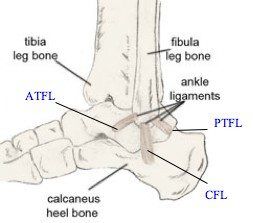
Inversion Ankle Sprain
The ankle is one of the most common sites for acute musculoskeletal injuries accounting for 75 percent of ankle injuries. Among athletes, inversion ankle sprains are the most common injury yet they are so often mistreated or not treated at all. A consequence of this neglect is a lasting weakness, an unstable joint and repeated sprains. This article will look at the most common ankle injury and its acute management.
Inversion Ankle Sprain
Inversion ankle sprains occur when the foot turns in or out to an abnormal degree relative to the ankle. The most common mechanism of an ankle sprain is a combination of plantar flexion and inversion where the foot is pointing downward and inward. The following video is an example of that.
Lateral Ligaments

The lateral ligaments are involved in an inversion ankle sprain and hence most commonly damaged. These ligaments are on the outside of the ankle, which includes the anterior talofibular (ATFL), calcaneofibular (CFL) and posterior talofibular ligaments (PTFL). Injury to the ATFL is the most common. When both the ATFL and CFL are injured together, ankle instability will be more noticeable. The PTFL is the strongest of the three ligaments and is rarely injured in an inversion sprain.
Ankle Sprain = Overstretched Ligaments
Ligaments are like tough rubber bands that help to provide stability to the any joint by limiting movement. When one or more ligaments is stretched beyond the normal range, a sprain results.
Ankle sprains range in severity from Grade I to Grade III and is useful for more than classifying the severity of the injury; it also directs treatment and prognosis.
| Grade | Signs & Symptoms |
| Grade 1 | Ankle sprains are painful, but they have no increased laxity when compared with the uninjured side. This correlates with mild stretching of the ATFL. |
| Grade II | Ankle sprains are painful and have an increased laxity on testing. This correlates with a complete tear of the ATFL and a partial tear of the CFL. |
| Grade III | Ankle sprains are usually painful and have an unstable ankle joint on examination. This correlates with complete ruptures of both the ATFL and CFL. |
Causes
Common causes of ankle sprains include stepping up or down on an uneven surface, particularly when wearing high heels; stepping wrong off a curb or into a hole. In athletics, common causes include landing wrongly after a jump shot and having to make quick directional changes as in tennis, soccer, and netball.
In essence, when the ligaments and muscles are not able to support the joint at a certain position, the ankle gives way. This is why training the muscles is very important when ligaments are “loose” or overstretched.
Management For Ankle Sprain
Treatment and rehabilitation starts the moment you have sprained your ankle. It is recommended that you start the R.I.C.E.R regime as soon as possible after the injury. An anti-inflammatory drug may be recommended and crutches provided for a few days if the ankle is too painful to bear weight.
Immobilisation using a brace or a cast can provide the injured ligaments with the rest they need to heal and reduces the risk of aggravating the injury. However, immobilisation should not be prolonged and must be followed within a week by exercises that prevent joint stiffness and muscle wasting.
Experiencing ankle pain? Click here to find out more about physiotherapy for ankle pain relief and how our physiotherapist at Core Concepts can help resolve your pain.
Related Articles
- Lateral Ankle Sprain: Why is it so recurrent? Lateral ankle sprain is one of the most common sites for acute musculoskeletal injuries accounting for 75% of ankle injuries.…
- Basketball Injuries - 3 Common Injuries & How… Basketball has gained popularity around the globe since its creation 100+ years ago. With a standard hoop located 3+ metres…
- 3 Common Ski and Snowboarding Injuries and How to Avoid them Winter sports like skiing and snowboarding are enjoyed by many people worldwide, with many Singaporeans travelling overseas to enjoy winter…
- BMT Injuries: Prevention & Management Injuries occurring from physical activities are a dime a dozen. However, they are more prevalent in intensive physical training sessions…
- Ankle Sprain - Causes, Management and Physiotherapy… Ankle sprains are more than just a temporary inconvenience – they can significantly impact your quality of life. Whether you're…

